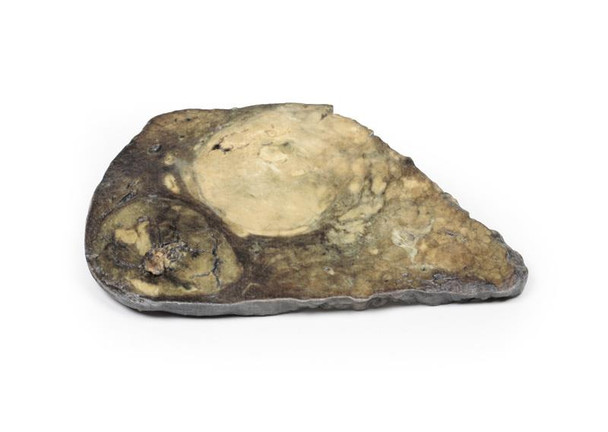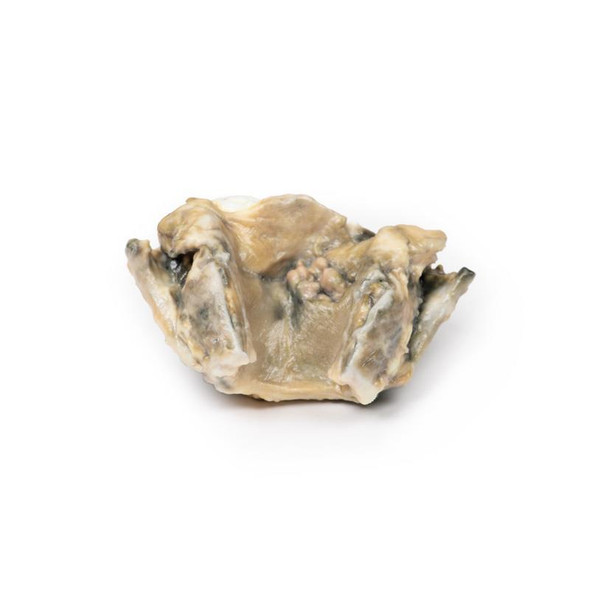Description
Clinical History
A 60-year old male is admitted with jaundice, melena and abdominal distension. He has a past medical history of untreated Hepatitis C infection from previous intravenous drug use. Further questioning reveals a 9-month history of significant fatigue, weight loss, nausea and intermittent dull right upper quadrant pain. Liver ultrasound demonstrated two large lesions within the liver. Soon after admission the patient dies from a suspected oesophageal variceal hemorrhage.
Pathology
This is the liver specimen of the patient on postmortem examination. The cut surface of the liver has a multinodular appearance consistent with macronodular cirrhosis. These multiple nodules are of varying size up to 2cm in diameter, and are separated by narrow bands of fibrous tissue. There are two large round tumors also visible. These are 8cm and 6cm in diameter with a variegated cut surface due to focal necrosis, hemorrhage and bile staining. This is an example of hepatocellular carcinoma that has developed on the background of a cirrhotic liver.
Further Information
Hepatocellular carcinoma is the most common primary malignant liver cancer. HCC arises from hepatocytes in the liver. Risk factors for developing HCC include viral infections (Hepatitis B and Hepatitis C), liver cirrhosis, aflatoxin exposure, Non Alcoholic Fatty Liver Disease (NAFLD), haemochromatosis and Wilson's Disease. The latter is an inherited disorder in which excessive amounts of copper accumulate in the body, particularly in the liver, brain, and eyes. HCC incidence is highest in Asia and sub Saharan Africa. There is a higher risk of developing HCC in males. HCC is associated with acquired driver mutation in oncogenes and tumor suppressor genes. The two most common driver mutations that can lead to HCC are gain-of-function mutations in beta-catenin and loss-of-function mutations in p53.
Clinically HCC can present with abdominal pain, fatigue, weight loss, abdominal fullness and less commonly jaundice, gastrointestinal or variceal bleeding. HCC metastatic spread is hematogenous with lung, abdominal lymph nodes and bones being the most common extrahepatic sites. Death usually occurs from cachexia, hemorrhage or liver failure. Treatment varies on the stage of the tumor and the patient's underlying general status and co-morbidities. Treatment can include surgical resection of ablation of the tumor, chemotherapy and liver transplantation can be curative.
Advantages
- Anatomically accurate and identical to real specimen
- No ethical issues - not real human body parts
- Reasonably priced
- Available within a short lead time
- Reproducible, several identical prints can be used as a classroom set
- Can be produced in different sizes to cater for the needs of the teacher
Human Cadavers
- Access to cadavers can be problematic. Many countries cannot access cadavers for cultural and religious reasons
- Cadavers cost a lot money
- High cost for establishing your own plastination suite
- Wet specimens cannot be used in uncertified labs
- Dissection of cadavers is a lot of staff time and that is a cost
- Storage of cadaver material needs special refrigeration etc. which has coast
- If you want another specimen you have to start all over again
Plastinates
- Costs
- Ethical issues
- Timeframe for plastination process
- Many countries do not allow their importation
- One of a kind
Superior 3D print results compared with conventional methods
- Vibrant color offering with 10 million colors
- UV-curable inkjet printing
- High quality 3D printing that can create products that are delicate, extremely precise and incredibly realistic
Clear Support Material
- To avoid breakage of fragile, thin, and delicate arteries, veins or vessels, a clear support material is printed on such spots. This makes the models robust and can be handled by students easily.



















